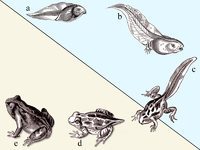
Photo from wikipedia
BackgroundLingonberry (Vaccinium vitis-idaea L.), one of the least studied fruit crops in the Ericaceae family, has a dramatically increased worldwide demand due to its numerous health benefits. Genetic markers can… Click to show full abstract
BackgroundLingonberry (Vaccinium vitis-idaea L.), one of the least studied fruit crops in the Ericaceae family, has a dramatically increased worldwide demand due to its numerous health benefits. Genetic markers can facilitate the selection of berries with desirable climatic adaptations, agronomic and nutritious characteristics to improve cultivation programs. However, no genomic resources are available for this species.ResultsWe used Genotyping-by-Sequencing (GBS) to analyze the genetic variation of 56 lingonberry samples from across Newfoundland and Labrador, Canada. To elucidate a potential adaptation to environmental conditions we searched for genotype-environment associations by applying three distinct approaches to screen the identified single nucleotide polymorphisms (SNPs) for correlation with six environmental variables. We also searched for an association between the identified SNPs and two phenotypic traits: the total phenolic content (TPC) and antioxidant capacity (AC) of fruit. We identified 1586 high-quality putative SNPs using the UNEAK pipeline available in TASSEL. We found 132 SNPs likely associated with at least one of the environmental or phenotypic variables. To obtain insights on the function of the genomic sequences containing the SNPs likely to be associated with the environmental or phenotypic variables, we performed a sequence-based functional annotation and identified homologous protein-coding sequences with functional roles related to abiotic stress response, pathogen defense, RNA metabolism, and, most interestingly, phenolic compound biosynthesis.ConclusionsThe putative SNPs discovered are the first genomic resource for lingonberry. This resource might prove useful in high-density quantitative trait locus analysis, and association mapping. The identified candidate genes containing the SNPs need further studies on their potential role in local adaptation of lingonberry. Altogether, the present study provides new resources that can be used to breed for desirable traits in lingonberry.
Journal Title: BMC Genomics
Year Published: 2017
Link to full text (if available)
Share on Social Media: Sign Up to like & get
recommendations!